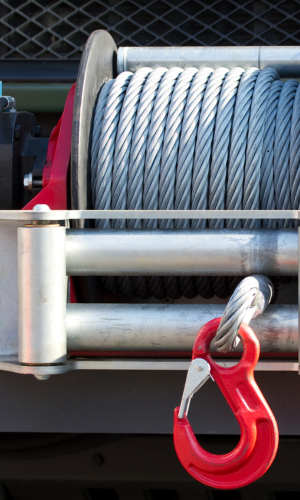Advantages of the Low-Speed Forestry Winch
The low-speed version of the Balfor forestry winch offers a number of significant advantages for those who require greater precision and control during logging operations. Thanks to the lower winding speed compared to the  The standard model allows for more gradual and safe traction, reducing the risk of jerks or sudden movements that could damage the load or equipment. This makes the winch particularly suitable for difficult or delicate situations, such as sloping terrain, dense forests, or areas with natural obstacles.
The standard model allows for more gradual and safe traction, reducing the risk of jerks or sudden movements that could damage the load or equipment. This makes the winch particularly suitable for difficult or delicate situations, such as sloping terrain, dense forests, or areas with natural obstacles.
The lower working speed also helps reduce wear on the cable and mechanical components, extending the life of the entire system. Operator safety is also improved, thanks to smoother and more predictable operation. Another important aspect is the possibility of using the winch with lower-powered tractors, reducing fuel consumption and operating costs without compromising pulling power. In short, this "reduced" configuration is an ideal choice for those seeking reliability, control, and long-lasting durability.
The Complete Guide to Forestry Winches: Discover Everything You Need to Know
The forestry winch is an essential tool for those working in the forestry sector, both professionally and as a hobbyist . In this guide, we will analyze in detail the main features of these devices, their practical applications, the different models available on the market , and the fundamental criteria for choosing the one best suited to your needs.
Whether you're a forestry enthusiast or an experienced timber handler, here you'll find all the information you need to understand how a forestry winch can simplify your work, increase safety, and improve productivity in your daily activities.
What is a forestry winch used for?
The forestry winch is an indispensable tool for moving and recovering logs and heavy materials in forestry. Designed to provide high tractive force, it allows operation even in difficult conditions, such as rough terrain or areas inaccessible by traditional means. Its primary function is to simplify operations such as felling, logging, and timber harvesting, while ensuring high efficiency and operational safety.
Using a forestry winch not only optimizes work times, but also reduces the physical effort required of the operator and helps reduce the risk of injury. For this reason, it represents a fundamental choice in any professional forestry management activity.
Maintenance and safety in the use of forestry winches
Regular maintenance is essential to ensure the longevity of your winch and ensure safe operation. After each use, it's important to thoroughly clean the equipment, removing soil, moisture, and debris that could damage components. Cables should be checked frequently for signs of wear or damage, and safety devices should always be functional and tested before use. A winch in good condition, used correctly, improves productivity and reduces workplace risks. Knowing the features of your tool helps you get the most out of it and remain completely safe.




 The standard model allows for more gradual and safe traction, reducing the risk of jerks or sudden movements that could damage the load or equipment. This makes the winch particularly suitable for difficult or delicate situations, such as sloping terrain, dense forests, or areas with natural obstacles.
The standard model allows for more gradual and safe traction, reducing the risk of jerks or sudden movements that could damage the load or equipment. This makes the winch particularly suitable for difficult or delicate situations, such as sloping terrain, dense forests, or areas with natural obstacles.














